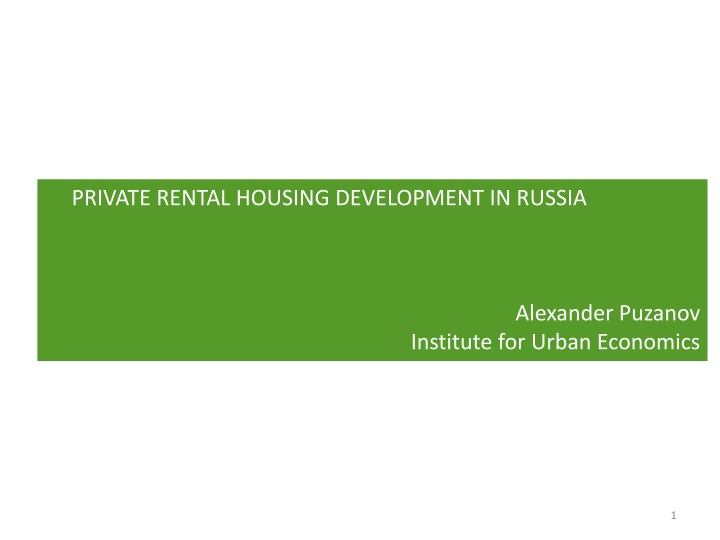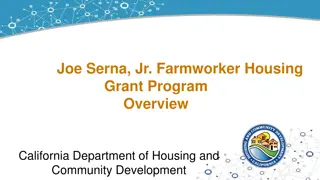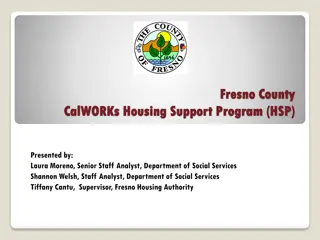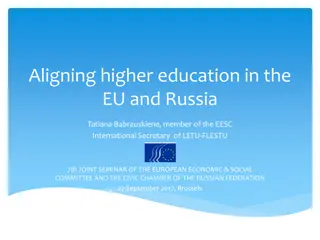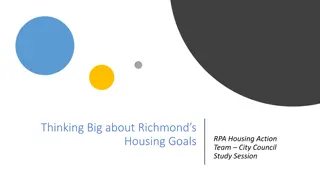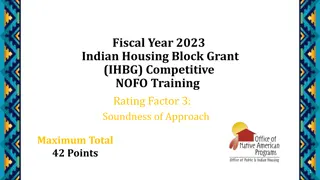Housing Development Trends in Russia: Key Insights
Explore the evolution of the private rental housing sector in Russia post-transition, housing construction scope, affordability trends in Moscow, income dynamics, market rent indicators in selected cities, and housing stock structure by tenure. Gain valuable insights from expert assessments and official statistics to understand the landscape of housing development in Russia.
Download Presentation

Please find below an Image/Link to download the presentation.
The content on the website is provided AS IS for your information and personal use only. It may not be sold, licensed, or shared on other websites without obtaining consent from the author.If you encounter any issues during the download, it is possible that the publisher has removed the file from their server.
You are allowed to download the files provided on this website for personal or commercial use, subject to the condition that they are used lawfully. All files are the property of their respective owners.
The content on the website is provided AS IS for your information and personal use only. It may not be sold, licensed, or shared on other websites without obtaining consent from the author.
E N D
Presentation Transcript
PRIVATE RENTAL HOUSING DEVELOPMENT IN RUSSIA Alexander Puzanov Institute for Urban Economics 1
Housing Construction Scope in Russia, in 20002011, (housing units) 3
Proportion of Russian households who can afford buying residential dwellings, conforming to floor space per capita standards, with owned and borrowed funds in 2004-2012, (%) 4
Proportion of Moscow households who can afford buying residential dwellings, conforming to floor space per capita standards, with owned and borrowed funds in 2004-2012, (%) 20% 18% 17% 17% 18% 16% 14% 14% 13% 14% 12% 10% 8% 6% 4% 2% 0% 2006 2007 2008 2009 2010 2011 : 2011 . - , , . 5
Dynamics of average actual housing price (blue line) and average annual real income (ref line) of the population, (the year 2004 = 100%) 200% 191% 190% 179% 178% 180% 170% 170% 157% 160% 148% 150% 156% 151% 141% 144% 140% 130% 127% 133% 120% 112% 110% 110% 100% 100% 100% 2004 2005 2006 2007 2008 2009 2010 2011 6
Indicators of market rent affordability in selected cities of Russia Market rent fee for Monthly per capita Proportion of a two-room Rental-price-to-income income households who can apartment ratio (for rent of a two- afford renting a two- (Rubles per month) room apartment) (Rubles per room apartment. % month) St.-Petersburg 21 513 27 063 0.26 38.3 Moscow Region 19 998 24 926 0.27 41.5 Yekaterinburg 24 476 24 314 0.34 29.9 Novosibirsk 17 731 17 283 0.34 30.5 Moscow 50 411 43 366 0.39 23.6 7
Housing stock structure by tenure (%) Rental housing Market Owner occupied Cooperative and other Social Austria Great Britain Netherlands Germany Finland Sweden USA Russia 23 17 32 5 16 17 1,0 13,51) 17 15 10 49 15 27 31,6 11,42) 56 68 58 46 66 38 66,4 74,93) 4 - - - 3 18 1,0 0,2 1) , , 2011 . 2) 3,4 % 8% 3) Expert assessment Source: Rosstat, Housing Statistics in the European Union 2010, US Census Bureau, Statistics Canada 8
Structure of rental housing in 2011 (% of total housing stock footage) Of which provided under: Private rental housing owned by legal entities Private rental housing owned by individuals Public (state or municipal) rental housing Rental contract Total rental housing Specialized housing rental contract (dormitories) Social rental contract Russian Federation 24,9 8 3,4 13,5 11,8 1,5 0,2 Moscow 34,1 10 2,0 22,1 20,5 1,5 0,1 9
Distribution of Russian households by housing needs and income groups, 2010 Numer of households with acute housing need (less 13 . Sq. m per person) and moderate housing need (less 2 0Sq. m per person) Target group Million households % of all such households Those with urgent need Those with urgent need Those with need Total Those with need Total Group 1: can afford buying dwellings with mortgage loans 4,3 1,2 3,1 16,3% 4,6% 11,8% Group improvements (dwellings with a larger floor area) with mortgage loans 2: can afford housing 3,8 1,3 2,5 14,4% 4,9% 9,5% Group 3: cannot afford improving its housing conditions even with mortgage loans, though the households do not belong to a group with the lowest income Group 4: consists of households with the lowest income Total 14,0 5,3 8,7 53,2% 20,2% 33,1% 4,2 2,1 2,1 16,0% 8,0% 8,0% 26,3 9,9 16,4 100% 37,6% 62,4% Source: IUE expert assessment basen on both Household Budget Survey and All-Russia Population Census for 2010 data 10
KEY FINDINGS 1. More than 2/3 households cannot improve their housing conditions either through purchase at the market using own means and loans or through public housing allocation Affordability of renting housing at the market is higher than that of acquiring housing with a mortgage (it varies across the cities, in Moscow the difference is twofold) The magnitude of rental housing sector is inadequate; the sector consists of the two drastically different segments Market rents in private rental housing in big cities is almost 10 times higher than regulated rents in public housing Most of private rental housing is semi-legal (assessment of annual budget losses in Moscow up to 1 billion USD) The current legislation is not tenure-neutral Investment projects in rental housing are not attractive for investors 2. 3. 4. 5. 6. 7. 11
Structure of supply at Moscow private rental market, June 2013 12
Key parameters of rental housing construction project : the case of Moscow 100 Rent for 42 sq. m apartment, th. Rubles per month 90 80 70 60 50 40 30 20 10 0 5 10 20 30 40 50 Paying back period r expected return on investment r=10% r=15% r=20% 13
RECENT DEVELOPMENTS -1 Support of economy class (affordable) housing is identified as a state priority Rental housing development is identified as a state priority Agency for Housing Mortgage Lending launched a new financial product Rental Housing Pilot projects on rental housing buildings construction are carried out in Russian regions 14
RECENT DEVELOPMENTS -2 Administrative procedures are widely used to identify private landlords but their efficiency is very low Key indicators of the Moscow voluntary registration system Results of campaign on identification private lanlords in Moscow 01.08.2012 . 17.07.2013 . Housing units registered 2012 2010-2011 Potential landlords identified 183,4 th. Under lease agreement 1636 7342 Officially checked by Ministry of Internal Under sublease agreement 3008 8652 7,8 th. Affairs Under free use agreement 2778 12453 Total 7422 28447 Files passed to tax authorities 3,9 th. Expected increase of number of taxpayers 2,0 th. 15
ANALYSES OF THE PRIVATE RENTAL SECTOR AS A POTENTIAL SOURCE FOR SOCIAL HOUSING 16
Types of landlords Low-income households renting out premises in the units they occupy themselves; Low and moderate income households who use renting as part of their income generating strategy (move to a worse housing or to suburban area) Households who temporarily left the city; Sentimental investors who acquired a second housing unit in ownership Households who have plans to use the leased housing unit in the visible future for household s needs Individual investors physical persons Legal persons: Providing housing in business or elite segments Providing housing with rents similar to those in public housing (usually big enterprises)
Risks of private landlords Damage caused by tenant Illegal sublettings Contract termination without proper notice Eviction under formal legal procedure (could take up to 2.5 years)
Types of tenants Young families, single person households (children of wealthy parents); Landlords of better housing using the difference as a source of income; Citizens using rental housing for professional purposes (artists et al.); Temporary migrants, including students; Newcomers accumulating means for housing purchase; Expats; Businessmen and officials; Owners of suburban housing
Risks of tenants Fake brokers (information agencies) Unexpected rent increase (including that after move-in investments are made) Double-letting (other forms of cheating) Deposits are not returned Excessive landlord s control (frequent visits) Cutting off means of communication (telephone, Internet)
Legal regulation in the private rental sector Two separate legal systems for public and private rental housing Regulation in the Civil Code is very general. However it contain clauses which inhibit sector development: the term of the contract cannot exceed 5 years unrealistic terms for evictions etc. The balance is shifted towards protection of tenant s interests (Global Property Research) High tax burden, inefficient tax regime Legislation does not protect both landlord and tenant, nor does provide incentives for leaving shadow zone
Institutional set-up More than transactions involve realtors Significant share of individual brokers and information agencies who do not bear any responsibility Informal procedures for conflict resolution and risk management Professional realtors promote certain institutional developments at the market: Model rental agreements Tertiary arbitration
Key elements of the rental housing development policy 1. Legalization of the existing market of private landlords 2. Setting framework for construction and acquisition of multi-apartment rental buildings in both market and non-profit segments 24
Key policy choices Establishing a new institution of non-profit housing vs modernizing inherited soviet social housing model New social housing providers regulated by special corporate legislation vs regulation by setting specific requirements and PPP contracts Ensuring stability of multi-apartment rental blocks: regulation by law vs regulation by contracts 25
Priorities for legal regulation 1. Setting legal framework for non-profit housing and multi- apartment block 2. Setting legal requirements landlords 3. Strengthening regulation of landlord-tenant relations 4. Special regulation for land allocation for construction of multi-apartment rental blocks 5. Changing the system of landlord s taxation 6. Stregthening responsibility for non-compliance with the law for specialized non-profit 26
Legalization of the existing market of private landlords 1. Setting incentives (including tax ones) for compliance with the law 2. Increasing attractiveness of legal rent contract 3. Support administrative control by control of those whose interests may be affected (neighbors) 4. Mandatory state registration of rent contracts with more that 1 year term 27
Special regulation for land allocation for construction of multi-apartment rental blocks 1. Privileged access to land plots 2. Legal regulation of special auctions for land plot allocation for housing construction - special auctions with target use of land plot for multi-apartment block construction - special auctions with start price below the market level (for non- profit housing) - special auctions where the subject is the price of future rent contract (for non-profit housing) - special auctions where the subject is the sales price of the built multi-apartment block to a specialized non-profit landlord 28
29 Construction of multi-apartment rental blocks with use of collective investments Model 1 Other investors Mutual Real Estate Investment Fund Investor VEB Lender Construction loan Builder/Owner Management company Multi-apartment rental block, market segment
30 Model 2 Projects supported with a mortgage Selling bonds fitting AHML standards Lender of the project AHML Purchase of MBS using the Pension fund means Mortgage loan for multi- apartment block puchase VEB Guarantee of providing eligible tenant Borrower Purchase of multi- apartment block Regional or local authority, Employer Tenants allowances Rant agreement
31 Model of non-profit rental housing development within state or municipal housing stock Model 3 Lender Munucipality Long-term lending Construction financed from the budget Multi-apartment rental block, non- profit segment Paying back (rent)
32 4 Model of non-profit rental housing development within by specialized landlords Means of founders Specialized landlords Lender Long-term lending (Model 2 mechanism could be used) Budgets or means of enterprises Payback of the loan () Multi-apartment rental block, non- profit segment
